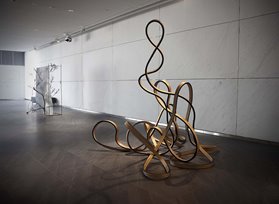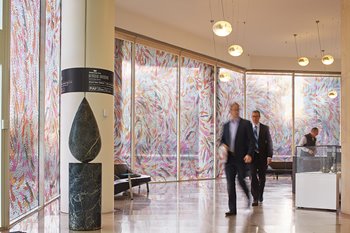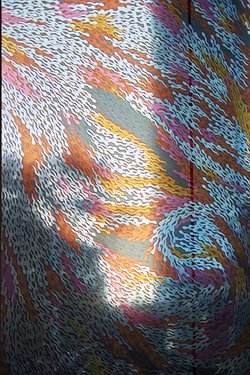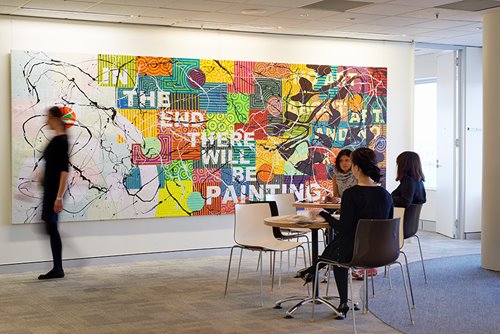 Inspiring Creativity and Community:
Inspiring Creativity and Community:
Art in the Workplace
Words by Paola Anselmi
Art has commonly been used as an exemplar of corporate identity, knowledge, authority, patronage and philanthropy. Over the last 50 years businesses have understood the experiential impact of art in the workplace and the outreach potential of an investment in the development of a company’s individual creative identity.
For a company that elects to invest in a creative presence in the workplace as an economic driver rather than a decorative by-product, the financial return of investment is more difficult to quantify. Qualitatively, however, studies have shown that the emotional and experiential return of investment is generated through an increase in staff satisfaction and efficiency.[1] For many employees fortunate enough to work in a workplace that meaningfully engages with the arts across the spectrum, it demonstrates that the company understands and cares for the employee and client experience equally.
Creating a successful, visually creative working environment no longer means a few paintings on the same wall in perpetuity. Genuine, lasting engagement is not immediate and fixed, it is fractal and continuous. This communication between object and observer grows exponentially through change, variation and exposure to new visual interactions.
Collecting through purchase or commission is by far the most common approach to creating a visually stimulating workplace but it is not an indispensable prerequisite. ArtLease[2] is an artwork rental program managed by Artsource. ArtLease Consultant Paul Parrin explains that the program has proven successful across diverse business ventures, showcasing the value of including carefully chosen artworks for public and work environments.
Aside from the financial taxation benefits of a leasing arrangement for businesses, it also facilitates the changeability of the work environment, supports practicing artists and eliminates the perceived obligation of developing a permanent collection to achieve artwork in the workplace. Leasing, however, also allows firms who do have a collecting strategy to fill gaps in their collection narrative, or test the efficacy of particular works, materials, size and intricacy before making a commitment to future purchase.
Artlease clients such as Ashurst Perth, ANZ Private and the Shire of Peppermint Grove, have all partnered with Artsource to enhance both public and private office spaces without the ongoing investment in corporate collection development.
However, most of the successful leading corporate collections have dedicated artwork acquisition and display policies, which partnered with organisational and public programs maximise their outreach potential both within the office environment as well as the public sphere. Bankwest, Wesfarmers, most local city councils and most metropolitan hospitals, to name just a few, all subscribe to this model, each with their own idiosyncrasies.
Wesfarmers has been an active participant in the visual art industry since General Manager John Bennison made his first acquisition for the company in 1977. With initial plans for Wesfarmers House in the pipeline, Bennison recognised the role that art could play in workplace environment, “to accentuate the value of art in the workplace and encourage an understanding of the importance to society of supporting creative thinking and artistic vision. ” [3]
This was not merely one individual’s lofty ideal. Bennison and subsequent company leaders such as Trevor Eastwood, Michael Chaney, and current CEO Richard Goyder have all been early adopters of new strategies to enhance and foster notions of community value through art, from their own employees through to the general public. Wesfarmers Arts has developed the company’s leader position not only in the very public arm of its arts support, but also more privately within the confines of their overall workplace.
 Companies such as Wesfarmers and Bankwest have understood that investment should be not purely in artwork as a financially sound blue chip stock, but an investment in the social benefits of a workplace environment and productivity.
Companies such as Wesfarmers and Bankwest have understood that investment should be not purely in artwork as a financially sound blue chip stock, but an investment in the social benefits of a workplace environment and productivity.
The last decade has seen an increase in research analysis and academic papers looking at case studies in the US, Britain, Canada and Australia that all have addressed various approaches to measuring the impact of art in the workplace. Art Works! The Importance of Art in the Workplace[4] by Jenny Thomas PhD and Patrick McCrae reviews the findings of a 2010 study by Dr J.S. Thomas from the University of Northumbria (UK). This study on the impact of the visual arts within the workplace extrapolated that while installing works in reception areas and meeting room was a positive step, it was only when artwork was installed in the main office areas, where staff could visually engage with the artworks, that a noticeable impact upon productivity, performance and work satisfaction began to surface.
Wesfarmers Arts’ approach is built on the idea of a trifecta centred on three main stakeholders: the artists, the employees and the community. The overarching attitude is one of ensuring a valued, original and engaging experience for all three stakeholders, equally.
 At Wesfarmers artworks are regularly moved throughout the workplace. Employees look forward to these rotations and being involved in the selection of new displays. The collection has a ‘no storage’ policy therefore new acquisitions are put on display as they arrive. This approach not only underpins the rotation of artworks and therefore a more stimulating working environment but also reinforces the ongoing relationship staff have with the collection and the program.
At Wesfarmers artworks are regularly moved throughout the workplace. Employees look forward to these rotations and being involved in the selection of new displays. The collection has a ‘no storage’ policy therefore new acquisitions are put on display as they arrive. This approach not only underpins the rotation of artworks and therefore a more stimulating working environment but also reinforces the ongoing relationship staff have with the collection and the program.
The workplace is where most of us spend the majority of our adult lives and many workers are focussed on repetitive tasks in a fixed location. Nailing an artwork to the wall and stepping away is not the way to engender stimulation long term. The impact is maximised when there is a concerted effort to foster interaction between the art and the staff. Wesfarmers for example, invites an artist to present an informal talk on their artwork to staff every few months on a Friday afternoon. Friends and family are also invited to attend. This direct engagement with the artist is invaluable. At other times employees are encouraged to respond to a work of their choosing and present their interpretation to colleagues.
Bankwest is home to another of the State’s significant corporate collections and sponsors the Bankwest Art Prize, one of WA’s most prestigious art awards. Bankwest Art Curator Sandra Murray explains, “Bankwest has a policy of only acquiring work suitable for an active work environment, so for example, we do not collect installation work and the collection is always out on display.” Murray describes the collection as ‘active’. The artworks are on display in all the staff areas, the two foyers and in the gallery. “The staff really appreciate the artwork and are always keen for more information. The Bankwest Art Prize is also a great source of pride for the staff and generates enthusiasm throughout the organisation.”
The new Bankwest building at 300 Murray Street must surely pose challenges given its very large spaces, open plan offices and abundance of glass. The large scale of some of the artworks, many of them Bankwest Art prizewinners, ensures that areas such as the lobbies become more human, relational and less impersonal.
“Art is a cultural asset for Bankwest that not only demonstrates its support for the WA arts community but highlights the invaluable role art has in humanising the environment and stimulating people,” says Murray.
Less walls and more glass is the way forward for many corporate headquarters. With the upcoming move to their new premises later in 2016, Wesfarmers Arts has had to also look at how to maintain the strength and diversity of its collection displays in a new work setting. “We’ve had to be pragmatic,” Carroll-Fairhall says. “The move to new premises has given us the opportunity to explore new directions such as a focus on digital works on top of current ongoing commitments, as well as a temporary installation program in the main lobby space.”
While change will always bring with it challenges, Carroll-Fairhall emphasises that, “The collection and its program are the glue that binds the aims and philosophy of the company, the wellbeing of staff and community engagement. Over the decades, it’s become integral to the identity of Wesfarmers and sits at the heart of our interaction with the community at all levels. It allows us as a company to participate in and learn from an important wider conversation in Australian society about the value of ideas and alternative ways of understanding and experiencing the world. This is why the art is literally everywhere at Wesfarmers, so that any individual engaging with the company whether it be as an employee, a shareholder, an artist can benefit from their encounter with the collection.”
The visual arts and the arts more broadly, have always played a core role in a holistic approach to wellbeing within diverse health environments. Renaissance hospitals in Italy, France and Spain focussed on healing the soul as an integral part of the body, an ideal that has evolved into a strong confraternity between wellbeing and the arts.
Aside from the regular display and rotation of the St John of God Hospital’s collection across its various Perth metropolitan sites, Collection Curator and Arts Program Manager Connie Petrillo, trialled live music performances in the wards and the success was immediate. “The trial was extremely positive,” says Petrillo, “the nurses immediately noticed a change in the ward. The patients were happier and more relaxed; overall the nursing staff was also moved in a very positive and noticeable way. Duties were carried out more smoothly and most importantly, there was a clear and obvious sense of pleasure throughout the day without compromise to the effectiveness of service care.”
St John of God’s art partnerships with the Black Swan Art Prize and Mandorla Art Award contribute to, and strengthen programs that inform the health care facilities’ in-house art activities. This programming model engenders an environment where staff, patients and visitors are all regarded as important primary stakeholders.
As the oldest hospital collection in Western Australia, the Royal Perth Hospital Art Collection has in the past been predominantly two dimensional and somewhat conformist in its collection and program directions. Art Curator Lance Hyde has built on the art collection’s 50-year history and opened it to a much stronger professional development engagement between artists, students and staff. “I have used the collection as focal point, an axis around which everything rotates. From here I have moved out to educational communities, bringing students from tertiary institutions into the hospital to develop an understanding of how the ‘health city’ works and how art can transform its communities, alter and enhance the built environment to create impact and participation.”
Through the development of study programs in partnership with Curtin University and Central Institute of TAFE, Hyde challenged students to see art and design as an integral part of the workspace, overcoming environmental constraints, material restrictions, approaching the built environment from the perspective of the both staff and patients.
 “I think this was quite an eye opener for some of the interior design students, who had really never thought of the possibilities available to them within a hospital environment.”
“I think this was quite an eye opener for some of the interior design students, who had really never thought of the possibilities available to them within a hospital environment.”
Royal Perth Hospital may not have to face the challenges of open plan workspaces and glass walls, but the constant competition for space certainly exists. Hyde explains, “In recent years a large amount of wall space in key areas was taken hostage by a series of large scale homogeneous posters demonstrating the quality and delivery of health care at the hospital. This corporatisation of spaces forced a rethink and led to the development of the Sculptural Visions program. This program focuses on the acquisition of small to medium size sculptural work displayed throughout the main hospital site, taking over the open spaces and engaging with the staff and public on a more physical level. It is working very well and comments have been very positive.”
It is difficult to measure or quantify the level of active engagement in the arts by staff when their investment of time and focus is rightly directed elsewhere. However it seems clear that both organisational and individual wellbeing, workplace satisfaction and perceived efficiency through stimulation and engagement in the workplace are strongly impacted by considered and participatory visual arts programs and display strategies.
.jpg.aspx?width=750&height=553)
Paola Anselmi is an independent curator and arts writer based in WA, currently undertaking a PhD at the University of Western Australia in Photography (Art History). Paola contributes to Australian arts publications and has held curatorial, management and research roles at the Art Gallery of WA, Royal Perth Hospital Art Collection, Centre for Contemporary Art, Luigi Pecci, Prato, the City of Perth and undertaken numerous public and private collection development projects and exhibitions.
Images (top to bottom)
1. Angela McHarrie, Less is more, 2014. Wooden rulers, wood, paint, screws, nuts and bolts. 210 x 185 x 200. Kevin Draper, Neither here nor there, 2014. Forged and painted steel, 190 x 105 x 160cm. Photographer: Christine Thomas.
2 + 3. Bharti Kher, Itch, scratch, raw, 2016. Digital design from an original work on optical clear film. 10 panels 496.0 x 2324.5cm. Window Dressing, Wesfarmers House temporary commission 2016, Wesfarmers Arts, Perth. Photographer: Rob Frith.
4. Richard Bell, Omega (Bell's Theorem), 2013. Acrylic on canvas, 180.0 x 480.0cm. The Wesfarmers Collection, Perth. Photographer: Rob Frith.
5. Susan Flavell, The shimmer, 2014. Cardboard, papier mache, hot glue, clag, glass, marble dust, glitter, gold leaf
200x120x300 cm. Represented by Turner Galleries. Jennifer Cochrane, Steel stack monument 2, 2014. Steel. Dimensions variable. Dallas Smythe (Tjanpi Desert Weavers), My Country, 2014. Tjanpi (wild harvested grasses), acrylic wool, raffia, jute string, polypropylene string, 200x60x60cm. Represented by Tjanpi Desert Weavers. Claire Bailey, Murmurs of a memory, 2014. Brass, copper, steel, wood, bone. Dimensions variable. Photographer: Christine Thomas.